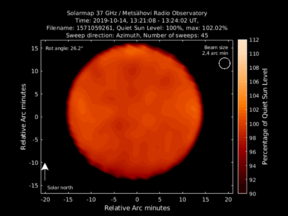Northern lights are the most visible sign of the Sun's activity – and other facts about our closest star

The Sun has been studied at Aalto University's Metsähovi Radio Observatory over 40 years. These observations form the basis for solar radio maps that provide researchers with an insight into the Sun’s behaviour, for example. Our solar researcher Juha Kallunki gives us five surprising facts about the Sun. Did you know this already?
1. Northern lights are the most visible sign of the Sun’s activity. They appear throughout the year, but particularly in the spring and autumn. The best time to observe the northern lights is during the dark autumn and winter months. The sky must also be clear in order for the northern lights to be visible.
2. Even if the sky is grey and the Sun is not visible to the naked eye, it is still possible to observe the Sun with radio frequencies – even on a cloudy day. Rain is the only thing that prevents radio observation. The Sun emits all wavelengths of electromagnetic radiation. Radio frequencies are a part of this electromagnetic spectrum. Radio frequencies also reveal signs of the Sun’s activity that cannot be detected by the naked eye or with optical telescopes.
3. Sunspots are the most well-known sign of the Sun’s activity. A sunspot is a dark area on the surface of the Sun. The dark areas are colder than the rest of the Sun’s surface, but radio frequencies show these active areas as warmer than other surface areas. The reason for this phenomenon is that matter rising from the sunspots becomes warmer as it enters the outer layers of the Sun’s atmosphere, which can be observed with radio frequencies.
4. The Sun is fuelled by hydrogen. When the hydrogen runs out in approximately five billion years, the Sun will slowly expand and become a red giant, enveloping the inner planets and even the Earth. Finally, the Sun will shrink into a white dwarf.
5. The Sun does not have any solid surface. Due to the high temperatures, all matter in the Sun is in the form of plasma, which is often called the fourth state of matter. The Sun’s magnetic fields regulate the movements of the plasma, so that the Sun rotates faster at its equator than at its poles.
Are you interested in solar research? Now it is possible, as Metsähovi has made the Sun’s observation data as well as other research materials available to all. For more information >>
The video below shows 41 years of observations of the Sun.
- Published:
- Updated:
Read more news

Aalto in 2024: Love pictured in the brain, wooden crystals that make fashion shine, recovering minerals from wastewater and more
This year has been another feast of science and art at Aalto University
Pengxin Wang: The internship was an adventure filled with incredible research, unforgettable experiences, and lifelong friendships.
Pengxin Wang’s AScI internship advanced AI research, fostered global friendships, and inspired his journey toward trustworthy AI solutions.
Major grant from the Kone Foundation for modern architecture research - Laura Berger's project equates building loss with biodiversity loss
Aalto University postdoctoral researcher Laura Berger and her team have been awarded a 541 400 euro grant from the Kone Foundation to study the effects of building loss on society and the environment.